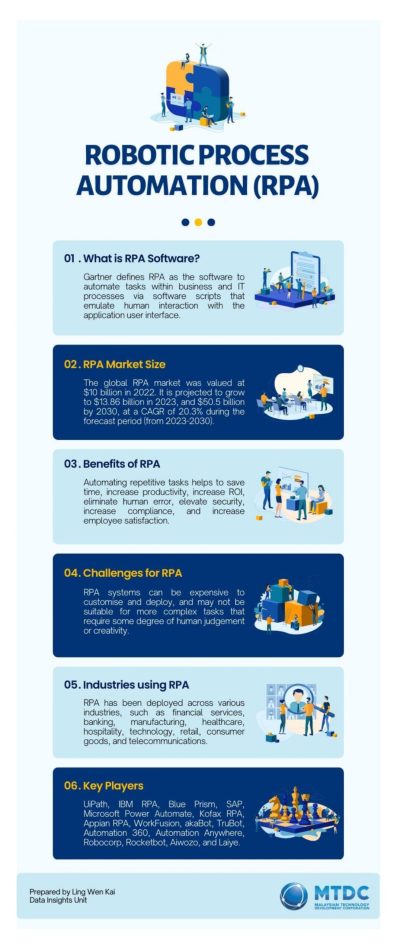About RPA
Gartner (2023) defines robotic process automation (RPA) as the software to automate tasks within businesses and IT processes via software scripts that emulate human interaction with the application user interface.
Although the name might conjure up images of a humanoid robot, RPA actually does not have a physical form, and is instead software that can help office workers to automate repetitive tasks that are done on a computer.
RPA is a system that can automate basic tasks, such as filling up forms or copying customer data across different applications. These steps were first recorded with the RPA software, and then an action—say a customer files a complaint—will trigger a series of other actions that are specific to an organisation’s unique workflow. These recorded steps are frequently referred to as “bots”, hence the name robotic process automation. Scripts for bots can be developed by programming or by using low-code and no-code graphical user interfaces (GUIs) that are native to the RPA software platform. (Gartner, 2023)
Background
The RPA market has been growing rapidly over the past few years. RPA in its purest form, however, is just the beginning, as cognitive capabilities are also being integrated with RPA, enabling machines to perform tasks normally reserved for human intelligence. (Polner et al., 2022)
According to Deloitte’s annual global survey of executives (2020), 78% of respondents said their organisations have embarked on a path to intelligent automation by implementing RPA, and 16 per cent plan to do so in the next three years. This is a significant increase from 58% in 2019 and 13% in 2015.
The global RPA market was valued at $10 billion in 2022. It is projected to grow to $13.86 billion in 2023, and $50.5 billion by 2030, at a CAGR of 20.3% during the forecast period (from 2023-2030). (Fortune Business Insights, 2023)
Application and Benefits of the Technology
RPA software can be taught a workflow with multiple steps and applications, such as receiving forms, sending a receipt message, checking the form for completeness, filing the form in a folder, and updating a spreadsheet with the name of the form, the date filed, and so on. (Frankenfield, 2022)
This helps reduce the burden for employees of completing repetitive, simple tasks. RPA performs these tasks quickly, at a high volume, and accurately. (UiPath, 2023) This in turn will help reduce labour costs and increase worker efficiency by speeding up their work and minimizing human error, thus freeing up human workers to prioritize more complex tasks.
RPA has been deployed across various industries, such as financial services, banking, manufacturing, healthcare, hospitality, technology, retail, consumer goods, and telecommunications. (Sureka, n.d.)
RPA can support various tasks such as invoice and payment processing, vendor contact management, reconciliation, legacy platform integration, account setup, auditing and compliance, fraud detection, and forecasting. It can also eliminate data entry for sales orders and invoicing, remove duplicate data, extract data from systems and combine it into a central repository for analysis. Additionally, RPA can automate entire workflows from data entry to data gathering to data processing and validation. (Ashling Partners, 2022)
Finally, RPA can even increase return on investment (ROI), productivity, and employee satisfaction. (Microsoft, n.d.)
Observation
There are various RPA solution providers in the market, including familiar names such as Microsoft (Power Automate), IBM (IBM RPA), and also Blue Prism and UiPath. (G2, n.d.)
Deloitte’s 3rd Annual Global RPA Survey Report found that 17% of organisations piloting RPA faced some or significant employee resistance. However, of those that have progressed to implementation or scaling stage, only 3% face resistance. The top challenges for those who had implemented and scaled RPA include, in order:
- Process standardisation
- IT buy-in and support
- Integration and flexibility of solution
- Stakeholder buy-in and expectations
- Employee impact
This is an indicator that RPA implementation has a high success rate, but organisations must shift their mindset and approach from experimentation to transformation to maximise the impact of RPA. In making this change, organisations must make the right strategic choices.

References
Ashling Partners. (2022, October 25). Which Processes Can Be Automated Using RPA? Ashling Partners. https://www.ashlingpartners.com/which-processes-can-be-automated-using-rpa/
Fortune Business Insights. (2023). Robotic Process Automation Market Size | Trends Analysis, 2030. Fortune Business Insights. https://www.fortunebusinessinsights.com/robotic-process-automation-rpa-market-102042
Frankenfield, J. (2022, February 14). Robotic Process Automation (RPA): Definition and Benefits. Investopedia. https://www.investopedia.com/terms/r/robotic-process-automation-rpa.asp
G2. (n.d.). Best Robotic Process Automation (RPA) Software 2023: Compare 140+. G2. Retrieved March 29, 2023, from https://www.g2.com/categories/robotic-process-automation-rpa
Gartner. (2023). Robotic Process Automation (RPA) Software Reviews 2023 | Gartner Peer Insights. Gartner. https://www.gartner.com/market/robotic-process-automation-software
Microsoft. (n.d.). Benefits of RPA—Robotic Process Automation | Microsoft Power Automate. Retrieved March 29, 2023, from https://powerautomate.microsoft.com/en-us/benefits-of-rpa-robotic-process-automation/
Polner, A., Wright, D., Thopalli, K., Telford, T., & Urbaniak, T. (2022). Automation with Intelligence (2022). Deloitte. https://www2.deloitte.com/content/dam/insights/articles/gb-164901-emea-intelligent-automation/DI_Automation-with-intelligence.pdf
Sureka, A. (n.d.). 8 Unparalleled Benefits of RPA That Will Power Up Your Business. Retrieved March 29, 2023, from https://www.clariontech.com/platform-blog/8-unparalleled-benefits-of-rpa-that-will-power-up-your-business
UiPath. (2023). What is Robotic Process Automation—RPA Software | UiPath. UiPath. https://www.uipath.com/rpa/robotic-process-automation
Watson, J., Schaefer, G., Wright, D., Witherick, D., Horton, R., Polner, A., & Telford, T. (2020). Automation with Intelligence (2020). Deloitte. https://www2.deloitte.com/content/dam/Deloitte/bg/Documents/about-deloitte/DI_Automation-with-intelligence.pdf
